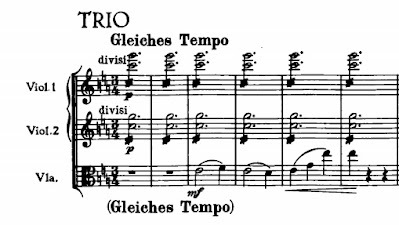Anton Bruckner labored long and hard before he got much recognition as a composer, studying compulsively for many years. He composed many choral pieces for the church in the beginning of his career, and finally settled on being a composer of symphonies.
He struggled to find an audience for his compositions, but the case was different with his organ playing. He was one of the most skilled organists of his time and was a master improviser on the instrument. That Bruckner created no great works for solo organ while being a recognized virtuoso is but one of the paradoxes of the man. But if his style of composition and orchestration for the orchestra is examined, he uses the orchestra itself like a huge organ, using combinations and mixtures like an organist uses the ranks of pipes to express what he hears in his head.
He finally received some recognition with his 4th Symphony written in 1874. But the man could get immersed in refinement of a work (or taking too much advice on how to make the work more pleasing to the public) for he revised most of his symphonies numerous times, including the 4th. This has lead to mass confusion of which version by which editor to use in performance. But even that has not stopped his music from becoming more and more popular and played more often in the concert hall.
Many biographers have commented on Bruckner's 'provincial' personality, his social awkwardness, and how nothing of the man is revealed in his music and nothing of his music is revealed in the man. He was trained to be a school teacher as his ancestors, and he was most of his life. But music eventually took over even this vocation as he became a professor at the Vienna Conservatory of Music.
His music aesthetic probably accounted for his lack of an audience early on. He remained original on the one hand, though out of step with his contemporaries, even the ones that he admired and followed. His hero was Wagner, but Bruckner wrote no operas, didn't even know what the stories of Wagner's operas were, but he knew Wagner's music intimately. Bruckner and Brahms were caught up in a musical-political fiasco not of their doing, as the sides were drawn for the 'keepers of the purity of musical tradition' on one side and the 'composers of the new music' on the other. The ridiculous notion that hearers needed to pledge their allegiance to one side while condemning the music of the other was kept going by music reviewers and others, some who cared little about art and everything about drama and intrigue. Bruckner had no head for this type of thing, and the members of the 'new music' group used him to his own detriment.
Through it all, Bruckner went on composing and finally had his largest success with his 7th Symphony written in 1881-1883. The premiere was in 1884, given by the Gewandhaus Orchestra under the direction of Arthur Nikisch. The work has been linked to Wagner for two reasons. Bruckner uses Wagner Tubas in movements two and four, and the second movement which has been called a tribute to Wagner.
I. Allegro moderato - The symphony opens with string tremolos, a mystical start of some other of his symphonies as well. The first theme has a range of two octaves and is first heard in the cellos and horn solo. Oboes and clarinets bring forth the the second theme, and a crescendo leads to the third theme, a theme that seems to walk at its leisure up to another crescendo and slight climax. The third theme continues its walk until the end of the exposition. Interspersed in this exposition of main themes there are other motifs that are played, as well as variants of the themes themselves.
The development section begins gently in the woodwinds and horns. The three main themes are sometimes restated in inversions of themselves. The brass leads a section that starts loud and gives the impression of leading to a climax, but it doesn't quite get there as the first theme returns and goes through some variants until it reaches a version akin to the opening of the movement, which signals the beginning of the recapitulation.
Themes are repeated, but not verbatim as Bruckner continues to expand on them. To be sure, Bruckner's first movements are in sonata form, but Bruckner's handling of the form is unique. After another crescendo and missed climax, the music begins a massive coda where the music builds in volume in the brass as the strings play tremoloes. And then the movement ends.
 |
| Wagner tuba |
III. Scherzo: Sehr schnell - Trio: Etwas langsamer - The third movement is a scherzo that is typical Bruckner; driving rhythms and a gentle trio section that is in marked contrast to the rest of the movement. The strings begin the movement with a figure that ushers in a trumpet playing a motif that Bruckner supposedly called "The crowing of the cock." The trumpet motif is repeated while the orchestra helps to build the scherzo to a climax. The trio is a gentler affair with the trumpet playing a part in it as well. The scherzo is repeated.
IV. Finale: Bewegt, doch nicht schnell - The finale rounds out the work, again in Bruckner's personal use of sonata form, complete with Bruckner's stylistic habit of stopping a theme without a bridge to the next, a few lesser climaxes before he unleashes the orchestra in a shortened version of the very first theme of the first movement that leads to a grand roaring from the orchestra that suddenly ends, along with the symphony.






















